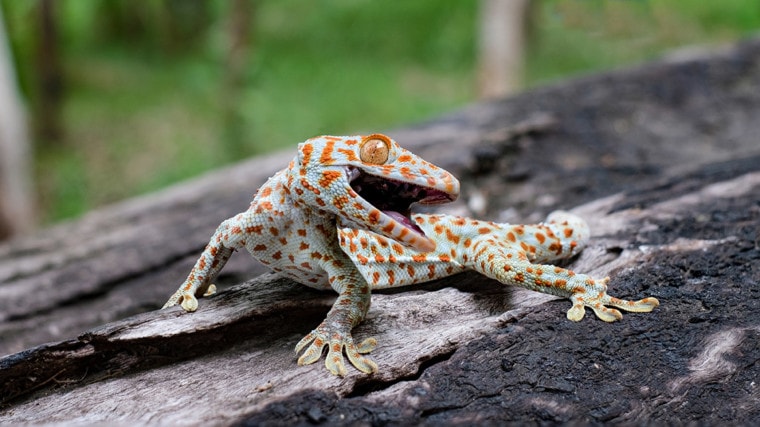
You’ve in all probability seen a lizard for those who’ve been to Florida. When you dwell there, lizards are seemingly a standard sight for you! These mates can get into your property or automotive and appear to be nearly all over the place. Whereas the Sunshine State is residence to over 50 species of lizards, solely 15 are native. All lizards play a task within the ecosystem. They prey on issues thought of pests, like bugs and rodents, whereas being prey for snakes and different bigger animals. Let’s check out the widespread species of lizards in Florida, each native and unique.
The ten Lizard Species Present in Florida Are:
Small Lizards
These lizards are little native Florida mates. Some could also be tougher to identify than others, so right here’s an inventory that can assist you distinguish them.
1. Inexperienced Anole
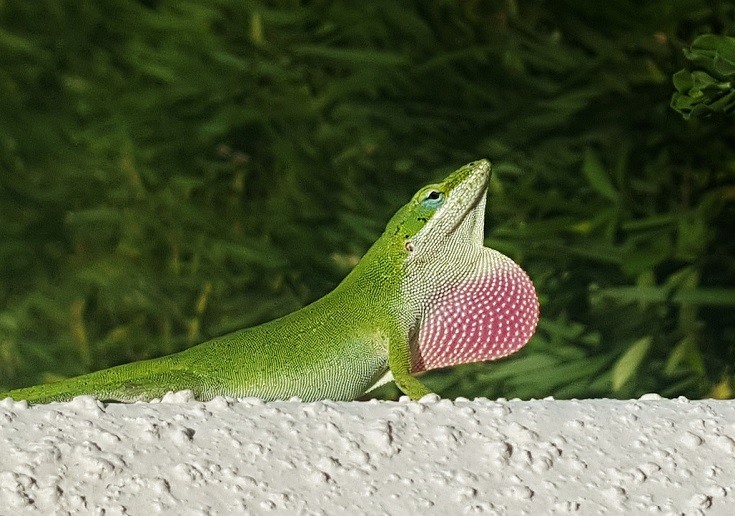
| Species: | Anolis carolinensis |
| Longevity: | 2 – 8 years |
| Good to personal as a pet?: | Sure |
| Authorized to personal?: | Sure |
| Grownup dimension: | 5 – 8 inches |
| Food regimen: | Crickets, worms, spiders, moths, and beetles |
The Inexperienced Anole is a standard sight in Florida. They’re typically mistaken for chameleons as a result of they will change coloration. Their our bodies are usually inexperienced, however they will change to brown, grey, or yellow. Their sticky toes assist them climb. Male Inexperienced Anoles have a dewlap or a little bit pink flap of pores and skin on their necks that turns purple when the lizard is about to combat an enemy or attempt to appeal to a mate. You could find these lizards nearly wherever. They like to bask within the solar and hand around in yards and gardens within the heat months.
2. Six-Lined Racerunner
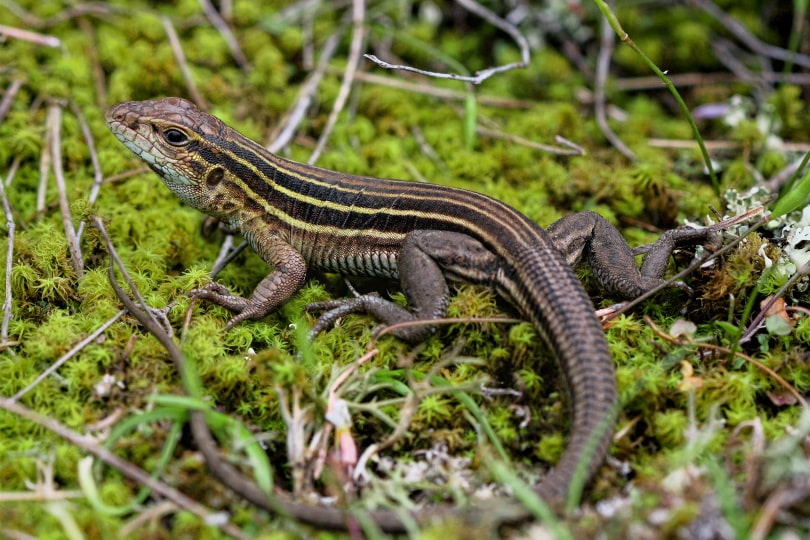
| Species: | Cnemidophorus sexlineatus |
| Longevity: | 6 years |
| Good to personal as a pet?: | Sure |
| Authorized to personal?: | Sure |
| Grownup dimension: | 6 – 9.5 inches |
| Food regimen: | Grasshoppers, crickets, and different bugs |
Six-Lined Racerunners are nearly all the time hanging out on the bottom. You’ll discover them in sizzling, dry areas which are open, like fields and dunes. They love the warmth. They transfer shortly, typically darting out to seize their prey after stalking it. You possibly can establish this lizard by the six yellow strains taking place the size of their our bodies from head to tail. The tail itself accounts for half of the lizard’s physique size and in some circumstances, may even be twice the size. They’ve darkish inexperienced or black our bodies, and the bellies are white or pale pink on females. For males, their bellies are pale blue with inexperienced throats. Fairly than having a scaly, shiny look, these lizards have a velvety look to their pores and skin.
3. Florida Scrub Lizard
| Species: | Sceloporus woodi |
| Longevity: | 1.5 – 2.5 years |
| Good to personal as a pet?: | No |
| Authorized to personal?: | Sure |
| Grownup dimension: | 5.5 inches |
| Food regimen: | Ants, spiders, and different small anthropods |
Along with being native to Florida, the Florida Scrub Lizard is barely discovered on this state. At roughly 5.5 inches lengthy, their tails account for 3 inches of their physique size. Their brown or grey our bodies are coated in tough scales, and there’s a darkish brown stripe on their sides from the neck to the tail. Males have brilliant blue patches on the edges of their our bodies and their throats, whereas females both lack the blue patches altogether or have faint ones. You could find these lizards in sunny, sandy areas which have timber to supply shade. Scrub is their habitat of alternative. Most of those lizards reside within the Ocala Nationwide Forest within the Sand Pine scrubs.
4. Jap Fence Lizard

| Species: | Sceloporus undulatus |
| Longevity: | 1 – 5 years |
| Good to personal as a pet?: | Sure |
| Authorized to personal?: | Sure |
| Grownup dimension: | 4 – 7.5 inches |
| Food regimen: | Crickets, grasshoppers, and fruit flies |
This lizard is discovered on tree trunks and fence posts of Northern Florida and far of the Southeastern United States. They bask within the solar throughout the day. At night time, they disguise, taking cowl below rocks and in logs and stumps. Their our bodies are brown or black to assist them mix in with their environment. It’s tough to identify them as a result of they cling to tree bark. Females are recognized by darkish horizontal stripes on their backs. Males have patches of blue on their undersides.
5. Reef Gecko
| Species: | Sphaerodactylus notatus |
| Longevity: | 10 – 20 years |
| Good to personal as a pet?: | Sure |
| Authorized to personal?: | Sure |
| Grownup dimension: | 2 – 2.5 inches |
| Food regimen: | Beetles, ants, and bug larvae |
The smallest lizard in North America is the Reef Gecko. Adults develop to be round 2 inches lengthy, however hatchlings are 1 inch lengthy after they’re born. They are often exhausting to identify as a result of they like to cover below issues like leaves and vegetation to hunt for bugs. They’re energetic at nightfall. Their scales are gentle brown, they usually’re coated in darkish brown spots throughout their our bodies. The females could be distinguished by three darkish, extensive stripes on their heads. Birds, snakes, and different lizards eat the Reef Gecko. Their coloring helps them disguise of their environment to flee predators.
Massive and Invasive Lizards
The next lizards usually are not solely giant, however they’re additionally not native to Florida. These massive, invasive species are ones to look out for as a result of some could be dangerous to individuals.
6. Brown Anole
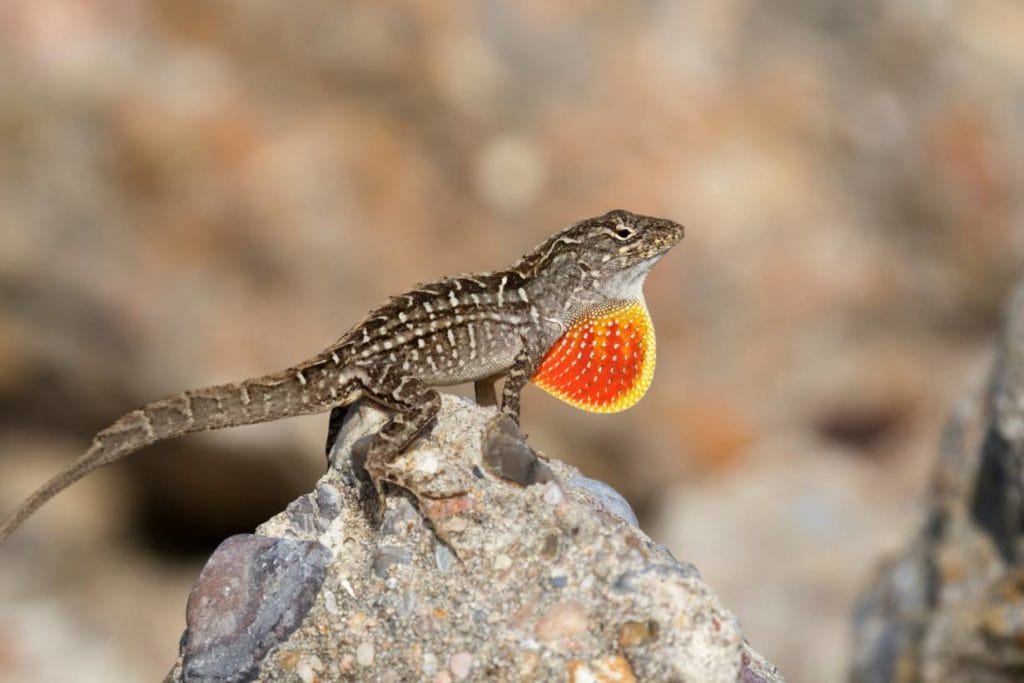
| Species: | Anolis sagrei |
| Longevity: | 1.5 – 5 years |
| Good to personal as a pet?: | No |
| Authorized to personal?: | Sure |
| Grownup dimension: | 9 inches |
| Food regimen: | Bugs, different lizards, lizard eggs, and their very own indifferent tails |
Not solely will these lizards eat their very own molted pores and skin and indifferent tails, however they may even eat their very own hatchlings and the hatchlings of the Inexperienced Anole. Since this invasive species arrived in Florida from Cuba, there’s been a lower within the Inexperienced Anole inhabitants. Brown Anoles have wider heads and shorter noses than different Anoles. They’ve lengthy toes that allow them to maneuver shortly, they usually can connect to any floor as they climb, even glass. Their our bodies are gentle brown with black-and-white markings on their backs and lightweight tan strains on their sides. Just like the Inexperienced Anole, the Brown Anoles have dewlaps, that are reddish-orange. They’re energetic throughout the day and love humidity. These lizards can thrive in any atmosphere however desire floor vegetation and locations that they will bask within the solar.
7. Inexperienced Iguana
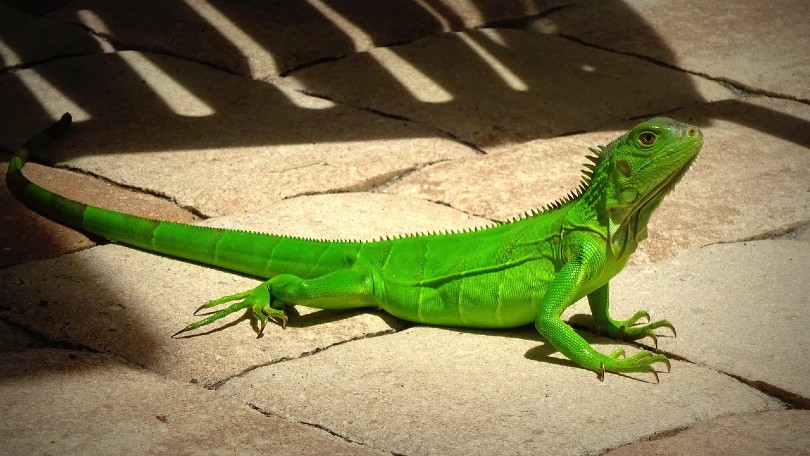
| Species: | Iguana iguana |
| Longevity: | 12 – 15 years |
| Good to personal as a pet?: | No |
| Authorized to personal?: | Sure |
| Grownup dimension: | 12 – 60 inches |
| Food regimen: | Leaves, vegetation, fruit, and flowers |
This lizard is taken into account an invasive species in Florida. The Inexperienced Iguanas are native to the tropical rainforests of Central and South America. In Florida, they’re thought of nuisance animals, destroying vegetation and crops. In addition they trigger harm to property by digging burrows that may collapse walkways and foundations. These giant creatures is perhaps referred to as Inexperienced, however they could be a number of colours, together with blue, lavender, brown, purple, black, and orange. They’ll detach their lengthy tails from their our bodies if they’re grabbed by them, permitting the lizard to flee to security and finally develop a brand new tail. Inexperienced Iguanas have jagged dewlaps that regulate their physique temperatures. In heat climate, you will discover Inexperienced Iguanas in timber. They’re good climbers, and in the event that they do fall, they typically land with out harm. They’ve sharp tooth and may pierce human pores and skin with their bites.
8. Argentine Black and White Tegu

| Species: | Salvator merianae |
| Longevity: | 15 – 20 years |
| Good to personal as a pet?: | No |
| Authorized to personal?: | Sure |
| Grownup dimension: | 60 inches |
| Food regimen: | Bugs, snails, rodents, fruits, and eggs |
These lizards are invasive and pose a risk to Florida’s wildlife, consuming the eggs of different species and inflicting destruction. They’re big and resemble an alligator, however they’ve a black-and-white banded sample down their backs and tails. They’re often discovered close to water and are good swimmers. Argentine Black and White Tegus are usually not aggressive to people however will chunk in the event that they really feel threatened. They’ve sturdy jaws and produce a painful, damaging chunk. Fortunately, heavy respiratory, tail thrashing, and toes stamping are all telltale indicators that you need to depart the Tegu alone and get away from them. They’ve been identified to cost individuals and chunk if these indicators aren’t taken significantly.
9. Tokay Gecko

| Species: | Gekko gecko |
| Longevity: | 10 years |
| Good to personal as a pet?: | No |
| Authorized to personal?: | Sure |
| Grownup dimension: | 13 –16 inches |
| Food regimen: | Small rodents, moths, crickets, cockroaches, and mosquitos |
The Tokay Gecko is a big gecko species native to South Asia. These invasive lizards can detach their tails to keep away from seize by a predator. The tails will thrash round, complicated the attacker, whereas the Gecko can slip away. There are two sorts of Tokay Geckos: black-spotted and red-spotted. These spots cowl a stocky blue-gray physique. Whereas they usually could be present in Florida in rocky or tropical environments, they will additionally make their houses within the partitions of homes. Most individuals don’t thoughts this as a result of these lizards can function pure pest management. They’re extraordinarily quick and may draw blood with a single chunk. The Tokay Gecko will clamp down and never let go. When you attempt to make this lizard launch their grip, they may solely grip tighter. They’ll cross micro organism to people via their saliva in a chunk wound, together with salmonella.
10. Nile Monitor

| Species: | Varanus niloticus |
| Longevity: | 20 years |
| Good to personal as a pet?: | No |
| Authorized to personal?: | Sure |
| Grownup dimension: | 70 – 80 inches |
| Food regimen: | Crabs, frogs, turtles, birds, and small mammals |
You could find this invasive lizard close to water in Florida. Nile Displays are olive inexperienced or black with lengthy, thick our bodies. They’ve cream or yellow stripes on their jaws and head that lead into bands and spots down their backs. They’re good swimmers and may keep underwater for quarter-hour. They bask within the solar close to the water on branches and rocks. This lizard is venomous however often not deadly to people. The poison will kill their prey and is harmful to small animals. These lizards gained’t assault a human except they really feel threatened, so for those who encounter them, depart them alone and again away from their space. Nile Displays are aggressive in captivity and don’t wish to be tamed. Most chunk wounds to people are the results of individuals attempting to maintain these lizards as pets.
Conclusion
There are various species of lizards in Florida, however most are innocent. From very small to extraordinarily giant, these lizards could be present in numerous locations everywhere in the state. Whereas no lizards in Florida pose a risk to human life, some could be thought of nuisance animals. The Nile Monitor, Tokay Gecko, Argentine Black and White Tegu, and the Inexperienced Iguana are lizards that may ship painful and generally bacteria-filled bites. This listing would possibly allow you to decide which lizards are innocent and which lizards ought to be averted for those who encounter one.
Featured Picture Credit score: Thichaa, Shutterstock


